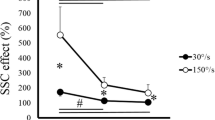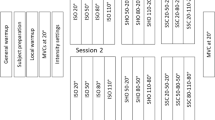Abstract
The stretch-shortening cycle (SSC) is a combination of eccentric and concentric muscle actions. The purpose of the study was to compare the SSC of four different groups comprising a total of 29 women and 30 men, divided according to sex and age (i.e. 20–40 years and 70–85 years). A KIN-COM dynamometer was used for strength measurements of the plantar flexion of the right foot. An electromyogram (EMG) from the gastroenemius muscle was recorded simultaneously. Maximal voluntary concentric muscle actions at 120° · s−1 and 240° · s−1 with and without prior eccentric muscle actions were performed. Average torque values of the range of motion between 90° and 99° of the ankle joint were extracted. All four groups were significantly stronger at 120° · s−1 than at 240° · s−1 for pure concentric actions. The average torque values of the concentric phases in the SSC movement were significantly higher than the torque values for pure concentric actions in all four groups and at both velocities. The EMG was significantly lower or unchanged in the SSC movement compared to a pure concentric action in all groups. A larger percentage increase in torque with prior eccentric action was found in young women compared to young men at both velocities. Our results suggested that the enhanced performance was even more marked when a concentric action was preceded by an eccentric action in the young women than in the young men, probably due to better utilization of elastic forces, but we could not demonstrate any age-related differences in enhanced performance with SSC.
Similar content being viewed by others
References
Asmussen E, Bonde-Petersen F (1974) Storage of elastic energy in skeletal muscles in man. Acta Physiol Scand 91:385–392
Aura O, Komi PV (1986) The mechanical efficiency of locomotion in men and women with special emphasis on stretch-shortening cycle exercises. Eur J Appl Physiol 55:37–43
Bosco C, Komi PV (1980) Influence of aging on the mechanical behavior of leg extensor muscles. Eur J Appl Physiol 45:209–219
Bosco C, Tarkka I, Komi PV (1982a) Effect of elastic energy and myoelectrical potentiation of triceps surae during stretchshortening cycle exercise. Int J Sports Med 3:137–140
Bosco C, Viitasalo JT, Komi PV, Luhtanen P (1982b) Combined effect of elastic energy and myoelectrical potentiation during stretch-shortening cycle exercise. Acta Physiol Scand 114:557–565
Dahlberg G (1940) Statistical methods for medical and biological students. Allen and Unwin, London
Falkel J (1978) Plantar flexor strength testing using the Cybex isokinetic dynamometer. Phys Ther 58:847–850
Fugl-Meyer AR, Gustafsson L, Burstedt Y (1980) Isokinetic and static plantar flexion characteristics. Eur J Appl Physiol 45:221–234
Komi PV (1984) Physiological and biomechanical correlates of muscle function: effects of muscle structure and stretch-shortening cycle on force and speed. Exerc Sport Sci Rev 12:81–121
Komi PV, Bosco C (1978) Utilization of stored elastic energy in leg extensor muscles by men and women. Med Sci Sports 10:261–265
Larsson L, Grimby G, Karlsson J (1979) Muscle strength and speed of movement in relation to age and muscle morphology. J Appl Physiol 46:451–456
Öberg B, Bergman T, Tropp H (1987) Testing of isokinetic muscle strength in the ankle. Med Sci Sports Exerc 19:318–322
Shadwick RE (1990) Elastic energy storage in tendons: mechanical differences related to function and age. J Appl Physiol 68:1033–1040
Sutherland DH, Cooper L, Daniel D (1980) The role of the ankle plantar flexors in normal walking. J Bone Joint Surg 62A:354–363
Svantesson U, Ernstoff B, Bergh P, Grimby G (1991) Use of a KinCom dynamometer to study the stretch-shortening cycle during plantar flexion. Eur J Appl Physiol 62:415–419
Svantesson U, Grimby G, Thomée R (1994) Potentiation of concentric plantar flexion torque following eccentric and isometric muscle actions. Acta Phys Scand 152:287–293
Vandervoort AA; McComas AJ (1986) Contractile changes in opposing muscles of the human ankle joint with aging. J Appl Physiol 61:361–367
Vandervoort AA, Hayes KC, Bélanger AY (1986) Strength and endurance of skeletal muscle in the elderly. Physiother Can 38:167–173
Author information
Authors and Affiliations
Rights and permissions
About this article
Cite this article
Svantesson, U., Grimby, G. Stretch-shortening cycle during plantar flexion in young and elderly women and men. Europ. J. Appl. Physiol. 71, 381–385 (1995). https://doi.org/10.1007/BF00635870
Accepted:
Issue Date:
DOI: https://doi.org/10.1007/BF00635870




